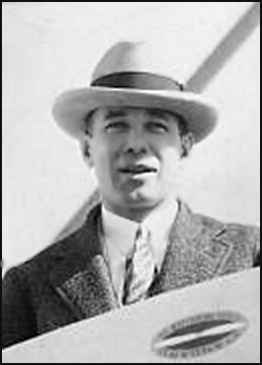WOOSTER-STANTON
STANTON HALL WOOSTER

LT

DIED IN ATTEMPT TO FLY NEW YORK/PARIS NON-STOP
Stanton Hall Wooster was born in Connecticut on April 1, 1895. After attendance at Yale University he was chosen for attendance at the U.S. Naval Academy from which he graduated in March 1917. He was later assigned to the Naval Air Station, Pensacola, where he qualified as a Naval Aviator in June 1920. Following a period of assignments as the pilot of large aircraft, Wooster was assigned to the Bureau of Aeronautics in 1924.
In 1919, a wealthy New York hotel owner publicly offered the Orteig Prize, a $25,000 reward to the first allied aviator(s) to fly non-stop from New York City to Paris or vice versa. LCDR Noel Guy Davis, a prominent Naval Aviator, became interested in this challenge and chose Wooster, who had a reputation as one of the Navy’s best large airplane pilots, to be his companion to attempt to fly a Keystone Pathfinder (NX179), a trimotor modified passenger airplane named “American Legion” across the Atlantic. By April 1927 their preparations for the flight were almost completed. The two men had supervised the construction of the airplane at Bristol, Pennsylvania, and made all of the test flights together. They had flown the plane with increasing loads of fuel and on April 26th prepared to make their final practice flight with a full load of gasoline before attempting to fly across the Atlantic. The two men took off from Langley, Virginia, but unfortunately after takeoff they found that at about 50-feet altitude the plane was unable to climb sufficiently to clear a row of trees. The plane was quickly turned to avoid the trees, but because of its speed it stalled and fell back to the ground into marshes that border the Back River about a mile from the airport. Upon striking the ground the plane skidded until it crashed nose first into a bog gully, crushing the cockpit and ripping the center motor from the mounting.
The two men on board were both killed in the crash. Commander Richard E. Byrd, who was also preparing to fly across the Atlantic issued a statement later in the day that the deaths of LCDR Davis and LT Wooster came as a distinct shock. He described them as old friends, brilliant, courageous air pioneers whose loss to aviation was irreparable and represented those pioneering pilots who dared to lay their lives on the line to reach for new heights in Naval Aviation.
LT Stanton Hall Wooster was buried with full military honors at Arlington National Cemetery in Virginia. Three weeks after his death, Charles A. Lindbergh won the Orteig Prize for his successful flight across the Atlantic on May 21, 1927, in the Spirit of St. Louis.
Submitted by CDR Roy A. Mosteller, USNR (Ret)

